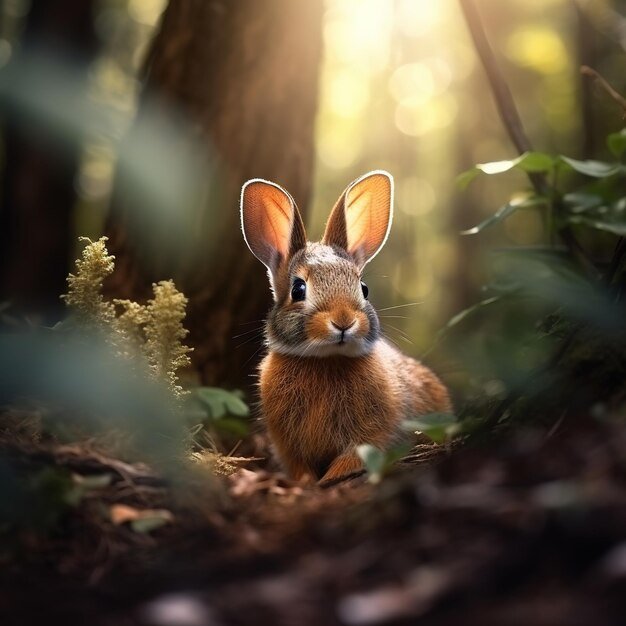
You might be wondering, what exactly do rabbits do in their ecosystems? Well, they serve multiple purposes that impact both their immediate surroundings and the broader environment. From the plants they eat to the relationships they form with other animals, rabbits are like tiny gardeners and prey that help maintain the rhythm of life in their habitats. By the end of this article, you’ll have a clearer understanding of the intricate web of life where rabbits are key players, and you’ll appreciate these little creatures more than ever.
Rabbits as Herbivores: Plant Dynamics
Rabbits are primarily herbivores, meaning they thrive on a diet of grasses, leaves, and other plant materials. This diet makes them vital for plant dynamics in their ecosystems. By nibbling on plants, they help control vegetation growth. It’s like they are nature’s lawnmowers, keeping certain plant species from taking over and allowing a diversity of plants to flourish.
In many ecosystems, overgrown vegetation can lead to a lack of light and resources for other plants. When rabbits graze, they create openings in the foliage that allow sunlight to reach the ground. This sunlight encourages budding plants and promotes a healthy habitat for small insects and birds. So, when you see a rabbit munching on a clump of grass, remember—it’s not just eating; it’s actively shaping its environment.
Moreover, rabbits contribute to soil health as they dig and burrow. Their digging actions aerate the soil, allowing air and moisture to penetrate deeper. This natural tilling promotes better plant growth, which further supports the ecosystem. So, in a way, rabbits are little environmental helpers working quietly behind the scenes.
The Rabbit Population as Prey
Rabbits are, without a doubt, a crucial source of food for many predators. Think of them as a link in the food chain, nourishing a variety of animals, from foxes and hawks to snakes and even domestic pets. This relationship illustrates a vital balance in nature; if rabbit populations were to decline, numerous predators would struggle to find food.
Conversely, when rabbit populations bloom, it can lead to a domino effect. Predators thrive, leading to a balanced ecosystem. However, this balance is delicate. Too many rabbits can lead to overgrazing, which can deplete plants and reduce food availability for other species. It’s a constant dance where every player, including rabbits, must perform their part.
In some ways, rabbits can be seen as sustainability champions. By being so prolific, they ensure that their species continues to provide for other wildlife. Their presence helps maintain the health of the ecosystem, keeping predator-prey relationships in check, which is essential for biodiversity.
Habitat Creation through Burrowing
Rabbits are also known for their burrowing habits, creating extensive networks of tunnels beneath the earth. These burrows serve as homes for the rabbits themselves, but they also benefit many other creatures. For instance, small mammals, insects, and even some birds may take refuge in abandoned rabbit burrows, using them for shelter and protection from predators.
This burrowing activity enriches the ecosystem further. By digging, rabbits contribute to soil structure, improving drainage and promoting nutrient cycling. Their burrows help rainwater percolate better into the ground, ensuring that plants receive the adequate moisture they need to grow. It’s like they are natural engineers, shaping their environment in ways that support many forms of life.
The importance of rabbit burrows doesn’t stop there. They can also help control pest populations by providing habitats for natural predators of harmful insects, thus leading to a healthier ecosystem. When you look at a patch of land with rabbits, you’re witnessing a hub of activity that supports a variety of life forms.
Seed Dispersal and Plant Regrowth
Rabbits aren’t just munchers—they’re also unintentional gardeners! When rabbits eat fruits and vegetables, they sometimes consume seeds along with them. After digestion, these seeds can be dispersed through their droppings. This process is known as seed dispersal, and it’s crucial for plant propagation.
By moving around and leaving droppings, rabbits help to scatter seeds throughout their habitat. This is especially beneficial for plants that need a variety of locations to grow. It ensures that new plants can sprout in different areas rather than clustering in just one spot.
Additionally, the droppings themselves are an excellent natural fertilizer, rich in nutrients that promote plant growth. This further enriches the soil and supports the life cycle of various plants in the ecosystem. So, rabbits are not just reducing weed populations; they’re also encouraging the growth of new plants and enriching the earth simultaneously!
Rabbits and Their Role in Biodiversity
Biodiversity is essential for a healthy ecosystem, and rabbits play a significant role in promoting it. Their presence supports not just their species but hundreds of others. Because they are agricultural eaters, they provide balance, preventing a few dominant plants from overshadowing less common species.
Moreover, when rabbits thrive, they create ripples in the ecosystem. Their behavior and habits provide insight into the overall health of their environment. For example, a sudden decline in rabbit populations can serve as a warning sign for ecological imbalances, like habitat destruction or pollution. You might think of them as environmental indicators, telling us when something is amiss.
In this sense, rabbits help maintain a rich tapestry of life, contributing to a wide variety of species and ecosystems. This diversity not only enriches our natural world but also ensures resilience against changes and challenges in the environment.
Human Impacts on Rabbit Populations
While rabbits play a vital role in their ecosystems, their populations face threats from human activities. Urban expansion, agricultural development, and habitat loss can significantly impact rabbit communities, leading to declines in their numbers. When we pave over fields or strip away dense foliage, we not only push rabbits away but disturb the entire fabric of life tied to them.
Additionally, hunting and farming practices can also threaten rabbit populations. In many regions, they are hunted for sport or food, which can lead to population pressures. It’s essential to understand that this doesn’t just impact rabbits; it reverberates through the entire food chain.
So, what can we do to support rabbits and the ecosystems they serve? Simple actions like preserving natural habitats, supporting wildlife-friendly farming, and practicing responsible land development can help maintain healthy rabbit populations. A thriving rabbit community means a thriving ecosystem, and honestly, it’s essential for all of us.
Rabbits are more than just cute creatures hopping around. Their role in their ecosystems is multifaceted and incredibly important. By acting as herbivores, prey, diggers, and natural dispersers of seeds, they help shape the environment and maintain a delicate balance of life.
Understanding the rabbit’s role in its ecosystem invites us to appreciate these delightful animals a little more. They are a reminder of how interconnected everything is in nature. So, the next time you spot a rabbit in the wild, take a moment to think about the impact this small creature might have on the entire ecosystem around it. They play a significant part in making our natural world vibrant and healthy, and we should support their role wherever we can.

